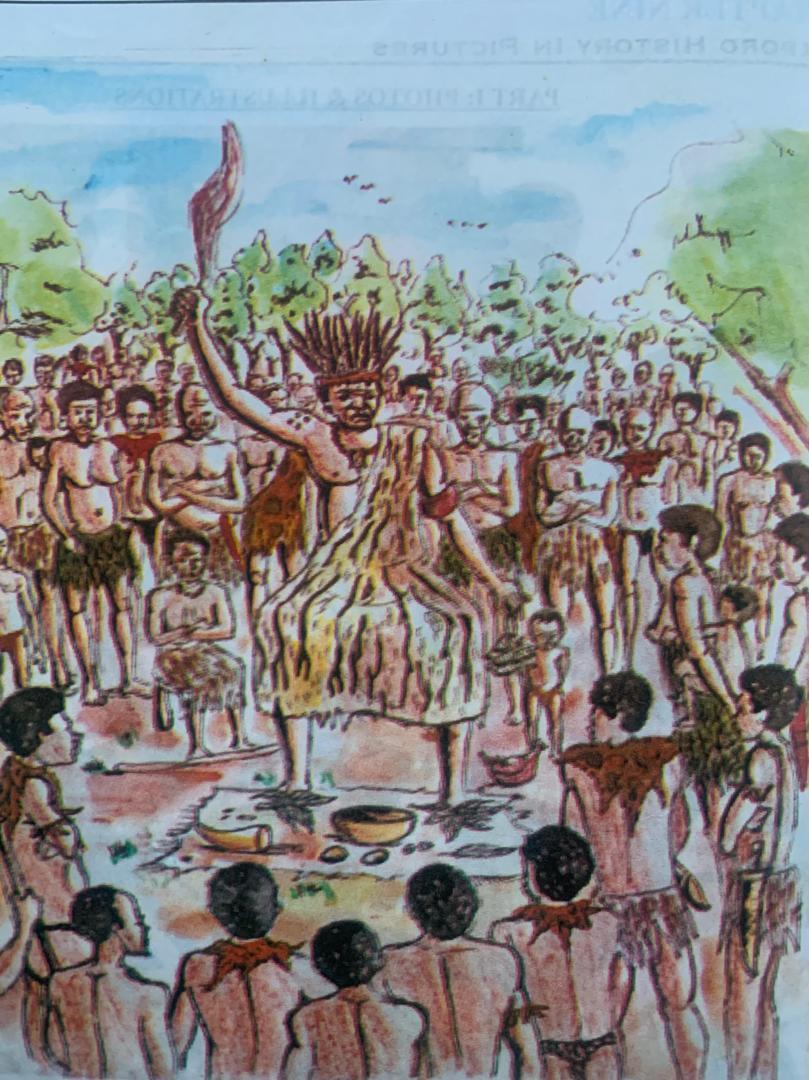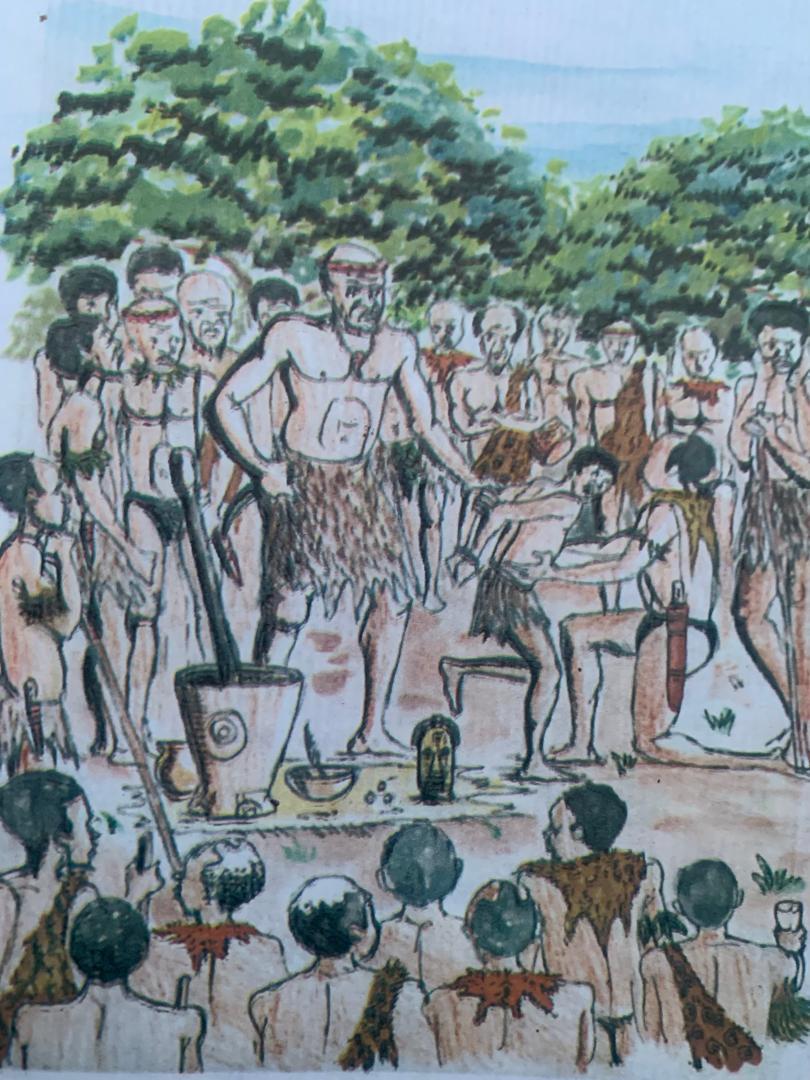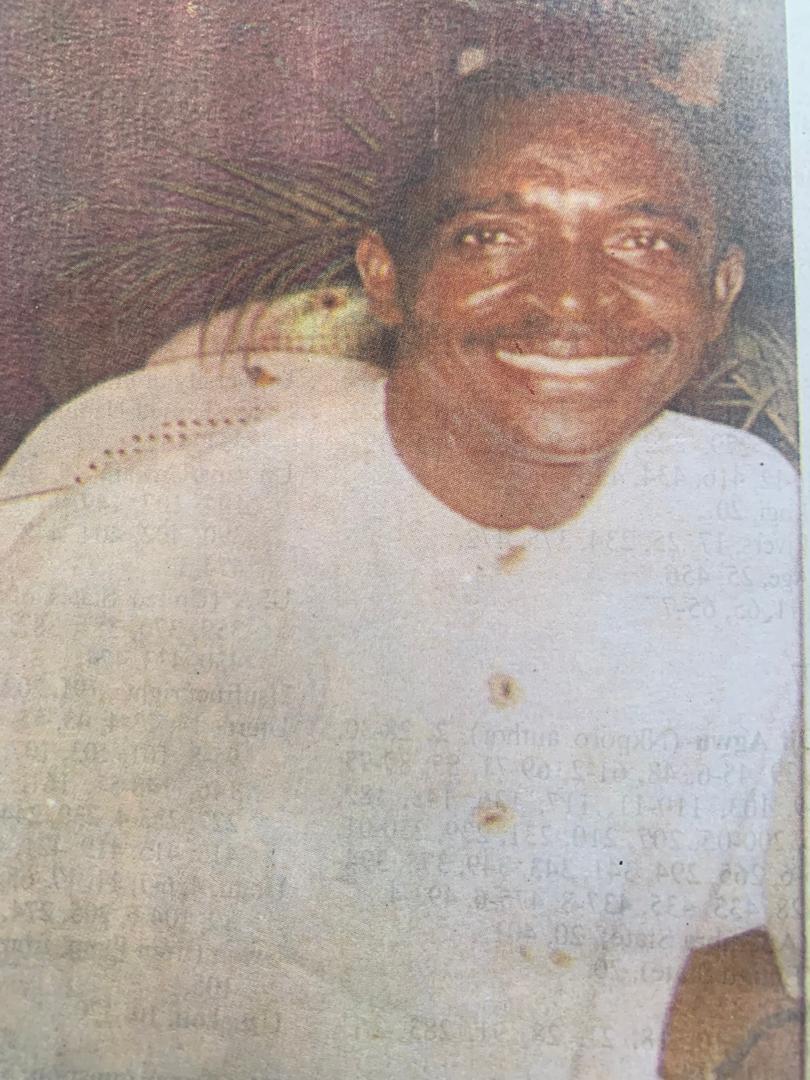
Estimate Age of Nkporo Between the victory over Afachima Achi and the first wave of settlement
The exact age, not simply an estimate, would have been the easiest thing to know if Nkporo people, in all their wisdom, had continued to take the Egwugwo/Igu Aro (Calabar) very seriously, combined with the Igwa Manwu, the Orders of Reign, the Age Grade system, and the Nsibiri language and system of writing on murals.
As it is today, only estimates based on carbon dating and other scientific means, as well as genealogical charts, can be attempted. We can only have the latter for now, and leave the more reliable scientific carbon dating, etc., to our children. The estimate is calculated from the oldest generations in Nkporo: that is, the male lines of sore earliest families. The author had, in this connection contacted, among others, records of his Jiire paternal ancestors that opened the ancient Nde Nkefa even while it was still at the point of initial entry at the Afia Eke Ochie or Agbala Amafo, and Uturu maternal ancestors that opened Amaeke after joining Nkporo at Ugwu Agbala., as well as the Iwoo-nta or Ezeaja section of Nde Uwom, and the direct descendants of Iwoo-ukwu and Jiire at Elughu, Obuofia, Ukwa, and Nde Nko. Correct estimates could equally issue from any other lineages that may convincingly establish that they or their Compounds were in the group of migrants, even if plus/minus a few margins of error, that first entered Nkporo., and to start with, such a migrant must have established one of the most original Compounds of his village. If the Compounds had changed positions, there ought to be clear proofs about places where they used to exist. The author's paternal and maternal families, following upon long-existing ancestral traditions, and closely connected with their royal and ancient Kamalu Otusis on the one hand, and the Jibia institution on the other hand, had continuously maintained well-kept genealogical records, starting on the father's side from Nnanyjukwu Ete Ojum James Arua, son of Igwe, son of Mba, son of Ekere, son of Ude, son of Ekere, son of Onu, son of Lekwa, son of Ude, son of Nkefia-uwa - founder of Nde Nkefa Compound after very many years of living with his father and grandfather at the former Afia Eke Ochie (the very first pount of settlement of the newly arrived people), son of Nkangnde/Nkannde (husband to & factous Nnenne Mgbom, alias Mbula A Bughi ji, from a then very Liny: probably still Etitiama-based settlerent of Obuofia), son of Ojukwu Jiire, one of the founders of Nkporo (c.1450), together with his siblings, Ounta ire and limbe "Oiwogho" Jire who lived opposite him at that Afia Eke Ochie, and cousins Egwupnay, Naika and Eze Eze Ezeaja • great grandfather to Uwom Eze, Favoured by am illustrious jibia lineage that evolved a highly systematized method of record-keeping based on eja/pots, the author's maternal lineage traces back through mother Jane Ojum, née Lin, 16° and last child of her Amakwy Ukwa-derived mother Migbo Ekuma Via, and 25" and last child of Alpalz, son of Iroha IlI, son of Ude II, son of Okoroafo II, son of Iroha lI, son of Ese, son of Aswo IL, son of Iroha I, son of Udurumma alias Ude I alias Udeagha, son of Okoroato I, son of Agwu l: founder of Ama-Ekenta or Ama-Eke/Amaeke Compound (named after his late father). initially settled at Agbala Amuty, before relocation to the present position, founder of the jibia institution in Nkporo, headquartered at the same Amaeke before a transfer to. Nde Uwom Compound where it went into an unlawful alliance with some people that transformed it into a certain "Jibia-ukwu" (a euphemism for the Ufie-Ufie), senior cousin to Oji Umokwo - creator of the 9 Kwar Nporo some generations later (Nkwo, grand or great grand-mother of Oji Umokwo at Uturu, had been a maternal relation to the great Ekenta)., one of the founders of Niporo (c. 1450)., son of the illustrious Ekenta, the Uturu Esim at Ugwu Ugbagha, conqueror of Afachima Achi, and the greatest hero of Nkporo ancient history, who made it possible for our people to peacefully arrive the Promised Land, even though he himself could not reach it, having immediately afterwards died, it is speculated, either in an astral travel, transcendental meditation, or itinerary medical practice.
From the author to his paternal ancestor were thirteen generations, and to his maternal ancestor were fourteen. But, Ekenta did not reach Nkporo. On the father's side, the names given independently to the author and many other people by Ete Ojum and Chief Kaly Igwe when alive, and separately also repeated by their several half-brothers, were compatible., and on the mother's side, the names given by the late Zacheus Kal Akpala, and the still living illiterate centenarian Chief Iro Kaly Ude Okoroafo and Gabriel Agy Egwu, were more or less also compatible, except in one or two areas in which Agu could not tell where Eso fell in, if he did.
Agu, maybe because of his hearing impairment, was also less consistent than the Chief in his order of names. Generally, therefore, the lists had been crosschecked for accuracy, and confirmed as reliable in their Oral Traditions. There is hardly any knowledgeable person from Nde Nkefa today who would not directly or indirectly trace his origin to Nkefia-uwa Nkangnde Ojiukwu Jiire, and none in Amaeke who would not so trace to Agwu Ekethe nta.

The second basis of the estimate is related to the first, namely, the Order of Reigns of the Ezeajas at Elughu, and of the Ezeogos in Etitiama, Obugfia, Ukwa, and a number of other villages. In most of the cases, not less than twelve generations were independently counted plus/minus only one or two. When more than fifteen, one could decipher either the shortness of some lives or reigns, or with particular reference to the Ezeajas at Elughu, either some minor confusion over regency and actual ruler, the multiplication of rulers within a single generation, or a possible re-counting of junior siblings or Princes as individual Kings in an ordinarily clear system of male primogeniture. Therefore, all logical estimates point to between twelve and fifteen generations from the death of Afachma Achi and 2006. It should be noted that soon after the dreaded leader of the Ibibio aggression and his soldiers were annihilated, preparations for the exodus immediately started and, helped by prior surveillance, the journey was afterward a straight and rapid movement, with only minor, possibly no more than few local weeks' delays at lyi-Ukwo and Ime Ama, before the final arrival and settlement in the about 2-kilometre zone between Ug oji. Nchara-nta Izuike, and Afia like Ochre, by the first waves of returnees. This should not suggest that the evacuation of Ugwu Agbala was or could have been total or tabula rasa, but it does suggest that the main body of the considerably large Nkporo family may have been in five first waves of arrival in the wake of the Isimbe-led reconnaissance and possible safe passage negotiated with some primitive jungle dwellers (maybe the Ogiri) that had declared the way secure and ready.
ycars. The shortest generation is about 30 years, and our purposefully expanded one abow So The expanded generation is to take care of possible missing names or links in genealogies, occasional late marriages, the fact that people generally used to live longer, even up to 130 to 180 years (Qjiukwu Jiire was reputed to have lived almost 150 years, and even recently, Chief Kama Mbuu who died about the mid-80s, was believed to have lived up to 142 years), etc. Hence, the approximate age of Nkporo, including from the victory over Afachima Achi, should be between 30 x 14 and 50 x 14 years, or between 420 and 700 years. Nkporo is, in effect, likely to have been established between 1305 and 1585, which could be rounded up to between 1300 and 1600. We generally favour the earlier dates, which are still conservative to some minds, with strong reasons and logic based, in part, on the estimated age of neighbours and the long years that Nkporo had travelled. Even though it doesn't necessarily guarantce accuracy, some people may, nevertheless, reason that the actual age of Nkporo should be the average of the two dates, meaning (400 + 700) ÷ 2, which should be 550 years, and translating into 1450 AD. plus/minus a few decades, as the time of the first waves of primary arrival.
We are aware that the gap between the two dates is relatively wide, but, as said earlier, the expanded generation is based on the fact that our ancestors usually lived far much longer than present generations, with an average life span sometimes ranging between 120 and 150 years. And, remember that we had also taken into account the fact that even in well-kept narratives, there may still be missing names in the lineages taken as frames of reference. We had also to compare our estimates with the estimated age of the communities that were established after Nkporo. Professor Ijoma (1986:15) had said that " the staggering role the Aro played in the era of trans-Atlantic trade suggests the existence of a dynamic polity in the area long before 1600". While Professor Njoku (2003:14), quoting another source, had declared that
"Ohafia was probably founded not earlier than 1450 and not later than 1500".

We remembered that the Nkporo people had traversed the two places long before their peoples arrived. Given that it took our people between 6 and 10 short generations (180 to 300 years) to travel from Ama Mpoto to Nkporo (with relatively long stays at Arochukwu, Udara Ebuo Elu, Ebiriba, and Ugwu Agbala), and that the "long before 1600" of the Arochukwu could be 1500, 1400 or even earlier, it seems that Nkporo left Arochukwu possibly either 1300-300 = 1000 AD, or 1400-300 = 1100 AD. And if Ohafia was founded not earlier than 1450 (after Nkporo had passed through it), we can assume that Nkporo people might have passed through it or left Udara Ebuo Elu between 1200 and 1300, taken between 50 and 150 years to open, live in, expand villages, and eventually pass through Ebiriba and Ugwu Agbala, to finally arrive Nkporo between 1350 and 1500, plus/minus a few decades, and substantially coinciding with our many other estimates The estimates can only be used with care., they are open to refinements by new generations, who could be aided by carbon-dating and other scientific means of precise periodization. Prof Obasi Igwe (Igwems)
Leave a comment
Your email address will not be published. Required fields are marked *

